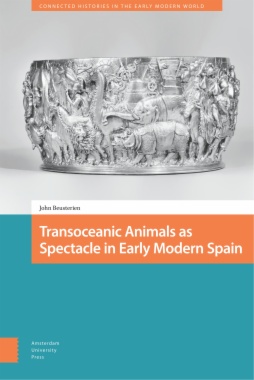Animal spectacles are vital to a holistic appreciation of Spanish culture. In Transoceanic Animals as Spectacle in Early Modern Spain, Beusterien christens five previously unnamed animals, each of which was a protagonist in a spectacle: Abada, the rhinoceros; Hawa’i, the elephant; Fuleco, the armadillo; Jarama, the bull; and Maghreb, the lion. In presenting and analyzing their stories, Beusterien enriches our understanding of the role of animals in the development of commercial theater in Spain and in the modern bullfight. He also contributes to growing scholarly conversations on the importance of Spain in the history of science by examining how animal spectacles had profound repercussions on the emergence of the modern zoo and natural history museum. Combining scholarly content analysis and pedagogical sagacity, the book has a broad appeal for scholars of the early modern Spanish Empire, animal studies scholars, and secondary and postsecondary instructors looking for engaging exercises and information for their Spanish language, culture, and history students.
- Cover
- Table of Contents
- Prologue
- Introduction: Armored Beasts and the Elephant in the Room
- 1. Hawa’i the Elephant and Abada the Rhinoceros
- 2. Fuleco the Armadillo
- 3. Jarama the Bull and Maghreb the Lion
- Conclusion: Biogeography as a Teaching Tool
- Appendix 1
- Appendix 2
- Index
- List of Illustrations
- Tables
- Table 1. The Lives of Five Animals in Spectacles in Early Modern Spain.
- Table 2. The Lives of Three Animals for a Biogeography Class Project.
- Maps
- Sixteenth-Century Journeys.
- Seventeenth-Century Journeys.
- Figures
- Fig. 1. Rhinoceros (1515) by Albrecht Dürer (National Gallery of Art, Washington, D.C).
- Fig. 2. Philip II’s 1562 elephant (1563) by Jan Mollins I (British Museum, London).
- Fig. 3. Abada (1586) by Philip Galle (private collection).
- Fig. 4. Zahir al-Din Muhammad Babur hunting rhinos in Swati (1589) (Walters Art Museum, Baltimore, Maryland).
- Fig. 5. Prince Salim at a hunt (1600–4) (Los Angeles County Museum of Art, Los Angeles).
- Fig. 6. Hobbled Ganda. Rhinoceros (1515) by Hans Burgkmair the Elder (Albertina Museum, Vienna). Circle added by author.
- Fig. 7. Hobbled Ganda. Frontispiece for “Forma e natura e costume de lo Rinocerote” (1515) by Giovanni Giacomo Penni (Biblioteca Capitular Colombina, Seville, sign.: 6-3-29[29])
(Copyright Cabildo Catedral de Sevilla). Circle added by author.
- Fig. 8. Abada and Her Mahout on the High Seas (2018) by Caleb Lightfoot and Yinting Fin.
- Fig. 9. Elephant with armor. “Tractado del elephante y sus calidades” (1578) by Cristóbal Acosta (Biblioteca de la Universidad de Sevilla).
- Fig. 10. Juan de Arfe’s self-portrait. Frontispiece from De varia commensuración para la esculptura y architectura (1585) (Biblioteca de la Universidad de Sevilla).
- Fig. 11. Gilded silver ewer (1583) by Juan de Arfe (Metropolitan Museum of Art, New York City).
- Fig. 12. A lion looks back at a rhinoceros. Detail from section of gilded silver ewer (1583) by Juan de Arfe (Metropolitan Museum of Art, New York City).
- Fig. 13. Abada as Madrid (2018) by Yinting Fin and Caleb Lightfoot.
- Fig. 14. Abada and Her Mother with India as Teat (2018) by Yinting Fin and Caleb Lightfoot.
- Fig. 15. Six-banded armadillo (1637–44) by Frans Post (Rijksmuseum, Amsterdam).
- Fig. 16. Portrait of Gonzalo Argote. Libro de descripción de verdaderos retratos ilustres, y memorables varones by Francisco Pacheco (Sevilla: Litografía de Enrique de Utrera, 1870) (Biblioteca de la Universidad de Sevilla).
- Fig. 17. Portrait of Nicolás Monardes at 57 years old (1569). Frontispiece of Historia medicinal, de las cosas que se traen de nuestras Indias Occidentales as reprinted in Estudio histórico de la vida y escritos del sabio médico, botanico, y escritor del
- Fig. 18. The Printed Image of Fuleco as Specimen. Historia medicinal, de las cosas que se traen de nuestras Indias Occidentales (1574) by Nicolás Monardes as reprinted in Estudio histórico de la vida y escritos del sabio médico, botanico, y escritor del s
- Fig. 19. Two armadillos (ca. 1560). Artist unknown (Rijksmuseum, Amsterdam).
- Fig. 20. America (ca. 1589). Designed by the Flemish artist Maarten de Vos and engraved by Adriaen Collaert (Metropolitan Museum of Art, New York City).
- Fig. 21. Amerique (1644). King of clubs playing card from “Game of Geography” by Stefano della Bella (Metropolitan Museum of Art, New York City).
- Fig. 22. Armadillo as America (Río de la Plata). Detail of Fountain with Four Rivers (1651) by Gian Lorenzo Bernini (photo by Jonathan Rome).
- Fig. 23. Philip II in Parade Armor (ca. 1570) by Alonso Sánchez Coello (Glasgow Museum of Art).
- Fig. 24. Tournament Armor of Charles V. Armeria real, ou Collection des principales pièces de la galerie d’armes anciennes de Madrid, 2 vols. and supplement (1839), by Achille Jubinal and Gaspard Sensi (Paris: Bureau des Anciennes Tapisseries Historiées)
- Fig. 25. The Monkey Painter (1660) by David Teniers the Younger (Copyright Photographic Archive Museo Nacional del Prado).
- Fig. 26. “About Lion Hunting” (1582) by Juan de Arfe. Argote de Molina’s Libro de la Montería (Chapter 30, page 10r) (Biblioteca de la Universidad de Sevilla).
- Fig. 27. “Hunting Bulls in the Arena” (1582) by Juan de Arfe. Argote de Molina’s Libro de la Montería (Chapter 38, page 16v) (Biblioteca de la Universidad de Sevilla).
- Fig. 28. “About Hunting Cimarrones in the West Indies” (1582) by Juan de Arfe. Argote de Molina’s Libro de la Montería (Chapter 37, page 14r) (Biblioteca de la Universidad de Sevilla).
- Fig. 29. Chīmalli (early sixteenth century) (Weltmuseum, Vienna).
- Fig. 30. Philip II’s Feather Shield (ca. 1581) (Armería Real, Madrid, Copyright Patrimonio Nacional).

